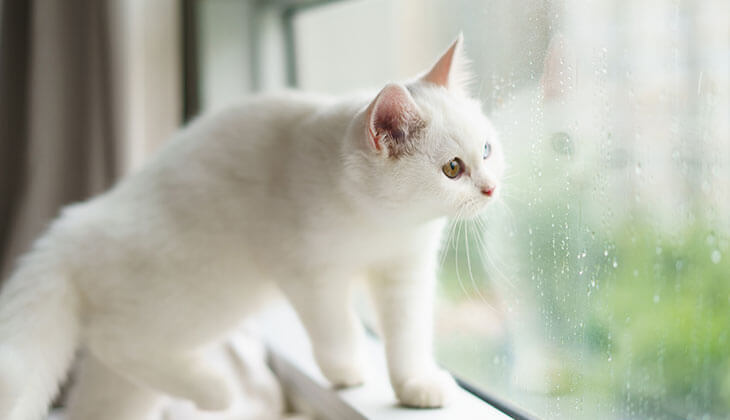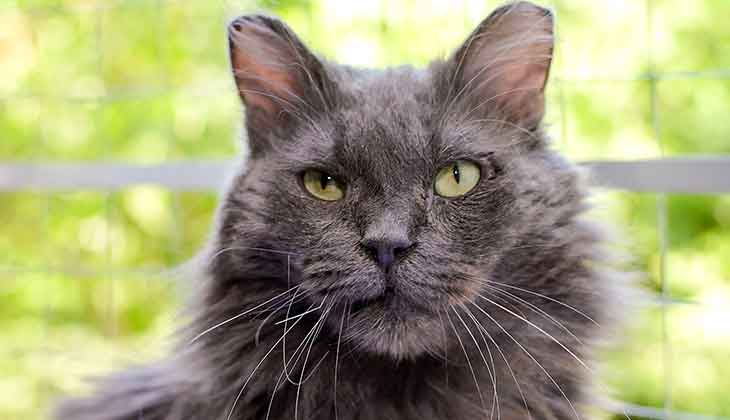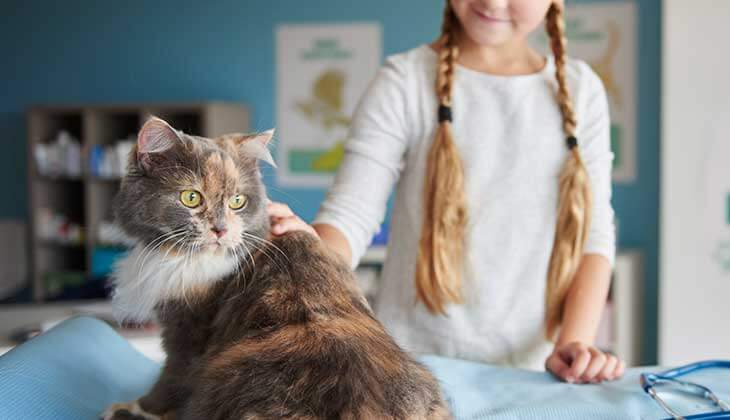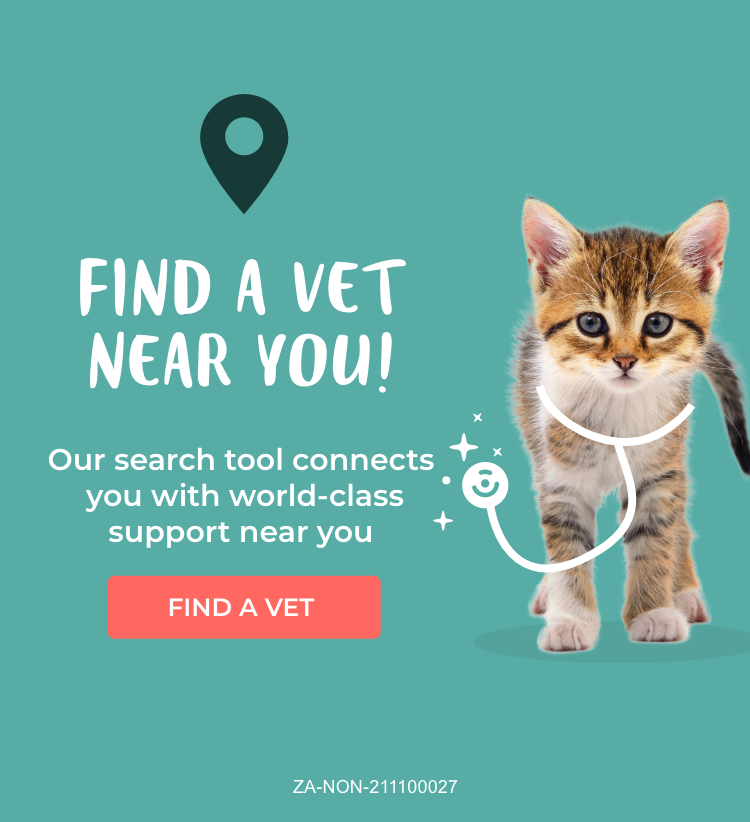
Hyperthyroidism and Your Cat
HEALTH & PROTECTION
20 Feb, 2022
READ 7 minutes
When you have a kitty, you may not hear anything about feline hyperthyroidism at wellness-visit check-ups, until your feline friend reaches middle age or older. That’s because feline hyperthyroidism is the number one endocrine disorder in older cats. In fact, hyperthyroidism is so common in older cats that many wellness guidelines recommend screening for this disorder once a cat turns seven years old. But what exactly is hyperthyroidism? And what signs should we, as cat families, be on the lookout for so that we can catch hyperthyroidism in its early stages? Experts tell us that early detection is the key to successfully managing this disease and maintaining our cats’ overall health, so what’s important for us to know?

WHAT IS THE THYROID?
The thyroid is a gland that produces thyroid hormones like thyroxine. It is divided into two lobes located on either side of the windpipe in your cat’s neck and in cats without hyperthyroidism, it cannot be felt. However, in cats with hyperthyroid, an enlarged thyroid gland is sometimes visible, but more often can be felt.
Thyroid hormones are essential for many functions in your cat including normal growth of the skeleton and brain in young animals. In cats of all ages, it also has an array of important functions including:
- Regulation of metabolism – basal metabolic rate, fat mobilization, and carbohydrate metabolism
- Regulation of the cardiovascular system – heart rate and ability of the heart to pump
- Mental state
WHAT IS HYPERTHYROIDISM?
In older cats, there are abnormal changes in the thyroid gland, which cause the thyroid to make and secrete very high levels of thyroid hormones. When this happens, it is called hyperthyroidism.
Thyroid hormones control the speed of your cat’s metabolism but when in excess, can cause a range of signs. The more thyroid hormone that is produced, the higher the metabolic rate, and the more calories your cat burns. It is a progressive disease with a slow, subtle onset, becoming more obvious with time.
Hyperthyroidism can affect both male and female cats equally however, Siamese, and Himalayan cats appear to have a reduced risk of developing this disease.

WHAT ARE THE SIGNS OF HYPERTHYROIDISM?
Early signs of hyperthyroidism may be hard to recognize. Some signs, including weight loss and high levels of activity (hyperactivity), are common but are not always recognized as abnormal. The gradual deterioration in body and coat condition can also be wrongly attributed to the “normal signs” of aging. Hyperthyroid cats might also be nervous or aggressive. Signs of hyperthyroidism may include:
- Weight loss (with or without a good appetite)
- Increased appetite (in some cats appetite is decreased)
- Poor body condition (including appearance of the coat and skin)
- Palpable thyroid nodule in the neck
- Rapid heart rate
- Hyperactivity, nervousness, stress, difficulty to handle
- Increased thirst and urination
HOW IS HYPERTHYROIDISM DIAGNOSED?
Your veterinarian will diagnose your cat’s hyperthyroidism from the history that you provide, a thorough physical examination, and laboratory tests. Conditions such as kidney disease and heart problems are also common in older cats so it is important to check for concurrent diseases which can influence the choice of treatment and prognosis for your cat. To confirm the diagnosis of hyperthyroidism your veterinarian will take blood samples to measure the levels of thyroxine circulating in the bloodstream and to evaluate your cat’s general condition to make sure he or she is not suffering from any other diseases. In some cases, even though your veterinarian strongly suspects that your cat is hyperthyroid, the tests may not be conclusive. This can be caused by a variety of factors:
- Your cat may be at a very early stage of the disease
- Thyroid hormone levels can fluctuate and can even be normal at some points in hyperthyroid cats.
- Other diseases / medications can influence thyroid hormone levels.
Your veterinarian may want to repeat the blood tests after a few weeks if the results are inconclusive.
In some cases, it might be necessary to carry out other additional tests as well. These tests could include:
- Special blood tests to evaluate thyroid gland function
- Diagnostic imaging (e.g. nuclear scintigraphy, ultrasound) of the thyroid, particularly before carrying out corrective surgery.

IF MY CAT IS HYPERTHYROID, WHAT ARE TREATMENT OPTIONS?
There are different types of treatments that are used for the long-term management of hyperthyroidism in cats. Drugs that block the production of thyroid hormones are used to reduce the levels of these hormones back to normal. This resolves the signs of hyperthyroidism and restores your cat to his or her old self. These drugs commonly come in pill form and there are specific ways to administer this medication to your cat and due to the nature of this medication, it has to be handled with care. Your veterinarian will advise you on how to handle your cat’s medication for your own and your cat’s safety.
First, place the pill between the thumb and index finger of one hand. Hold the top of the cat’s head and gently but firmly grasp the cheekbones with the thumb and index finger of the other hand just behind the canine teeth. Then, gently tilt the head back until the cat’s eyes are facing upward. Usually, the cat’s jaw will drop open on its own. If not, apply a little pressure on the lower jaw with your middle finger. Bring the pill to the cat’s mouth and keep your middle finger over the small incisor teeth to keep the jaw open. Deposit the pill as far back on the tongue as possible. Immediately close the mouth. You should gently stroke the throat or blow in the nostrils to encourage swallowing and work as fast as possible to avoid being bitten.
These drugs may also be available as a topical that must be administered carefully into the inside of the ear.
Surgical thyroidectomy involves the removal of one or both lobes of the thyroid gland. Cats usually undergo 2-4 weeks of medical treatment to improve their condition and minimize the potential complications associated with anaesthesia, for example, due to heart irregularities. Surgery is curative in many cases, but hyperthyroidism can recur if there is thyroid tissue at other sites in the body (ectopic tissue). Your veterinarian will discuss with you whether your cat is a good candidate for surgical thyroidectomy.
Iodine is necessary for the proper functioning of the thyroid gland and the production of thyroid hormones. Dietary iodine restriction may be an option for cats that can be fed this type of diet exclusively. This can be a particular challenge in multi-cat or multi-pet households. It takes longer for cats managed on an iodine-restricted diet to reach normal levels of thyroid hormone and these cats also tend not to gain weight as well as cats managed using other therapies.
Hyperthyroidism is usually manageable and there is a good chance that your cat will return to normal. Treatment aims to reduce the level and ultimately the effects of excessive thyroid hormone. Cats diagnosed with hyperthyroidism must be treated as soon as possible. The longer a cat is left untreated the more detrimental the effects of the excessive thyroid hormones.
Your veterinarian will discuss your pet’s treatment plan with you and together you can decide on the best option for your cat.









